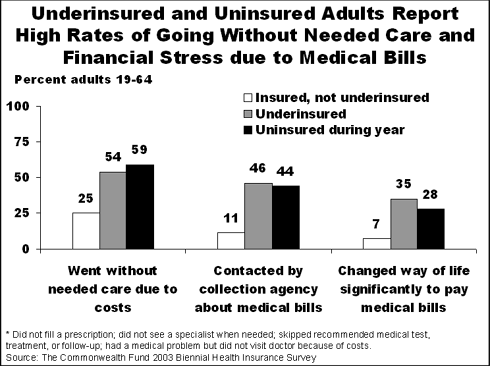New York City, June 14, 2005—In addition to the 45 million uninsured adults in this country, at least another 16 million adults were underinsured in 2003, meaning they did not have enough financial protection to cover their health care expenses, according to a web-exclusive study released today in the journal Health Affairs. An estimated 61 million adults, equal to 35 percent of adults ages 19–64, had either no insurance, sporadic coverage, or insurance that exposed them to catastrophic medical costs during 2003. The study, conducted by researchers at The Commonwealth Fund, is the first in over a decade to assess the growing numbers of underinsured adults and how their lack of adequate coverage affects their health, as well as their finances and related stress.

- Half of the underinsured (54 percent) and uninsured (59 percent) went without at least one of four needed medical services—double the rate of those with adequate insurance.
- Two-thirds of sicker adults who were underinsured and three-fourths of sicker adults who were uninsured went without needed care because of costs.
- Nearly half of underinsured sicker adults with chronic diseases or poor health did not adhere to medications.
- Thirty-eight percent of sicker underinsured adults did not see a doctor when sick, and one third did not follow up on treatments or care recommended by their doctors because of cost.
- Seven out of 10 low-income adults (household income 200 percent below federal poverty level) were either uninsured or underinsured during the year
- Nearly half (46 percent) of underinsured adults were contacted by a bill collection agency in regard to medical bills About 7 percent of continuously insured adults spent 10 percent or more of their income on family medical expenses during the year. The study highlights the importance of taking income into account in insurance plan design. This includes limiting out-of-pocket cost exposure to not more than ten percent of income in general, and five percent for those with low incomes. Yet, in today's markets income-related designs rarely occur. "Unless this country starts to pay attention to health insurance benefits design, it is going to be harder to distinguish the insured from the uninsured," said Commonwealth Fund President Karen Davis. "What we are seeing is a health care divide between people who have adequate insurance, and those who have inadequate insurance. Without policy action the number of underinsured is likely to increase."


